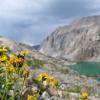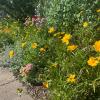Bugs are in trouble, and our yards are part of the answer
Pale green with delicate tails fluttering in the darkness, the luna moth is an enchanting presence in nighttime gardens of the eastern US. Unfortunately, like other giant silk moths (family Saturniidae), the luna moth has been impacted by an introduced tachinid fly that parasitizes its caterpillars, leading to declining numbers and fewer sightings.

Even so, all of us have the opportunity to help the luna moth, and other at-risk insects, recover. Wildlife conservation sometimes focuses on protection of large spaces, far away from our cities and homes, that support many kinds of life. These wilderness areas are very important, but they aren’t the whole story. While big animals, like elk and bison, can only thrive in large spaces, bugs are pretty tiny! Many bees, butterflies, beetles, and other invertebrates can take advantage of smaller spaces.
Any of us with even a tiny postage stamp of a yard — or just a deck or balcony — can create a vital part of the habitat bugs need to flourish. And if each of us — you, your neighbor, your friend down the block — takes a step, that adds up to a lot.
Small habitat features can make a big difference
To use our little slices of the world to support bugs, we need to provide the right conditions for these animals to take shelter, find food and water, and reproduce. Traditional landscaping practices almost never meet all these needs for most animals. But it’s easy to add small features, like a rock pile, water source, or leafy corner, that can make a big difference for wildlife!
These microhabitats are our focus at Xerces for this year’s Earth Week! Each day, we will be highlighting the importance of a different habitat feature, teaching you how to build it, and introducing you to the wonderful bugs that need it to thrive.

“Dead” plant materials are the perfect home for pollinators to live in
Bringing wildlife back into our neighborhoods can be as easy as just tidying up less. For many invertebrates, fallen leaves, steams, brush piles, and old logs are homes, food, or both!
Leave the leaves
Many bugs could benefit from us hanging up our rake or leaf blower. Some, like springtails and roly-polies, happily munch away at leaves and recycle those nutrients back into the soil. Others use the leaves as a blanket to stay warm during the winter. For example, luna moth caterpillars build themselves a shelter out of leaves tied together with silk within which they will pupate. This shelter starts in a tree but during autumn falls to the ground, where it will rest among the leaf litter through the winter. The next generation of adults will emerge the following spring — but what happens if we rake or blow the leaves and shred them or send them off for composting?
This fall, find a location to keep at least some leaf litter so bugs can survive the winter! A thin layer (less than 2” thick) won’t kill your grass. Spread them over your flower borders or vegetable plot, where they will help build soil. Use them as mulch around trees or shrubs — they are as good as bark chips and free! Pile them at the base of a fence or hedge, or in an unobtrusive corner of your yard. Don’t keep them where they will be a problem (no blocked drains!) or if there are plant disease issues, but there is almost always somewhere that works. You could even keep a layer of leaves in a deck or balcony planter. You will experience a more diverse bug community come spring!

Save the stems
Instead of cutting back everything at the end of summer, leave the stems of perennial plants. The seed heads will feed goldfinches and other birds, and the stems will provide some shelter. Once the temperatures are reliably in the 50s again in spring, cut them to 8” to 24” high. Those old stems can become nests for many of our solitary native bees. The plants will grow up around them and you’ll not know they were there, but the bees will. There is no need to clean up these stems. When occupied, the bees will remain in the nest for the entire year, so the nesting stems should stay in place.
Compared to artificial options such as bee blocks and bee hotels, natural materials like stems are much healthier options. They allow for nests to be more spread out, and break down naturally with time, helping to control diseases and parasites.
As the weather warms, watch your new nesting sites for insect activity. Stems that have been blocked at the cut end with natural materials such as leaves, mud, pebbles, grass, or resin mean that there is a nest inside. In colder weather, stems with unblocked cut ends may also be occupied by overwintering adults. Over time, you’ll be rewarded with the chance to see, among many others, stem-boring moths, carpenter bees, and leaf-cutter bees!

Build brush piles and “plant” a log
Brush piles provide hibernation sites for mourning cloaks (Nymphalis antiopa) and other butterflies, soil access for ground nesting bees, daytime shelter for fireflies (Lampyridae), and food for a diversity of wood-eating beetles and other organisms.
Brush piles can be as big or small as you have space for. You could use branches from pruning, firewood, or fallen sticks. Build the brush pile by stacking branches, largest first, with plenty of gaps and crevices between them. You can hide the pile behind a hedge or wildflowers to keep the yard looking clean, or get a pollinator habitat sign to teach others about the habitat’s value.
In time, your brush pile will settle as nature breaks it down into valuable nutrients for your yard. You can add more brush on top, or build a new one elsewhere.

If you have access to a log, try “planting” it! The moist spaces under logs and behind peeling bark are great for ground beetles (Carabidae) and other predators of common garden pests. Bees and butterflies are more likely to nest and overwinter in dryer parts of logs.
Lay the log horizontally and bury one end a few inches into the soil. Surrounding parts of it with a few smaller branches or rocks will provide extra cover and improved habitat. If you are bringing logs into your space from elsewhere, be aware of any restrictions on moving logs or deadwood. Some areas have strict rules to prevent spread of invasive species or diseases.

Adding microhabitats is an easy way to make a difference
As you consider what you can do, remember that you don’t have to do it all in one go. Look at your yard and see what’s possible to do this year. Then decide what you might do next year.
Every small change you make will make your yard better, and will pay off when you see more beautiful wildlife around you. Together, we can reweave the fabric of our environment.
Resources and further reading
- Nesting & Overwintering Habitat for Pollinators & Other Beneficial Insects
- How to Create Habitat for Stem-Nesting Bees
- Leave The Leaves: Winter Habitat Protection
- Leave the Leaves yard sign




